USS Valkyrie
The USS Valkyrie (NCC-74877) is a Sovereign -class exploratory cruiser assigned to the Fourth Fleet's Expeditionary Group . The Valkyrie is a long-range explorer capable of conducting 10-year missions in deep space it also provides humanitarian aid to colonies as well as planets on the frontiers of Federation space. It also conducts SAR, and defensive missions whenever needed. It is currently under the command of Captain Geronimo Fontana .
- 1 Namesake & Lineage
- 2.1 Construction & Launch
- 2.2.1 Dominion War
- 2.2.2 Attack on Mars
- 2.3.1 Return to Service
- 2.3.2 First Deployment
- 3.1 Main Bridge
- 3.2 Ready Room
- 3.3 Observation Lounge
- 3.4 Battle Bridge
- 3.5 Odin's Palace
- 3.6 The Horn
- 3.7 Valhalla
- 3.8 Strategic Operations Center (StratOps)
- 4.1 Commanding Officers
- 4.2 Executive Officers

Namesake & Lineage
A Valkyrie is a figure in Norse mythology depicted as a warrior woman on horseback, a wolf or boar, and armed with a spear, who decides the fate of warriors in battle and carries the dead to Odin's Valhalla.
The Valkyrie joins an impressive lineage of vessels to bear the name, the USS Valkyrie NCC-74877 ( Sovereign -class) is a highly versatile exploration vessel widely considered to be one of the most advanced starships in the service of the Federation. The immediate successor to the USS Valkyrie NCC-74777 ( Galaxy -class ), the current iteration has only been in service for a year and half.
- Service: 2250 - 2256
- Class: Nimitz -class
- Status: Decommissioned
- Service: 2256 - 2275
- Class: Constitution -class
- Status: Refitted
- Service: 2275 - 2282
- Class: Constitution II -class
- Status: Destroyed
- Service: 2282 - 2290
- Class: Excelsior -class
- Status: Scuttled
- Service: 2290 - 2342
- Class: Excelsior -class refit
- Service: 2342 - 2363
- Class: Ambassador -class
- Status: Scraped
- Service: 2363 - 2373
- Class: Galaxy -class
- Service: 2373 - Present
- Class: Sovereign -class
- Status: Active
Looking to make a name for themselves in the history of this great name, the crew are fresh from a number of more mundane activities at the turn of the century and have now embarked upon a new mission of exploration, with the ship currently headed towards Epsilon Station and the wilderness that is the ‘Galactic South’, an area ripe for scientific exploration.
Service History
Construction & launch.
In 2372, construction on the Valkyrie began at Utopia Planitia Fleet Yards where she was laid down and construction began. The USS Valkyrie NCC-74877 was commissioned in 2373 at Utopia Planitia. The ship underwent a shakedown cruise under the command of Captain Voss on the 12 February, 2373.
Post-Launch
Dominion war, attack on mars, geronimo fontana's command, return to service, first deployment, physical configuration.
The Valkyrie is a Sovereign -class exploratory cruiser largely in the stock configuration for the 2400s.
With a little over 20 decks, the ship has hundreds of rooms and locations that serve a variety of functions for the crew.
Main Bridge
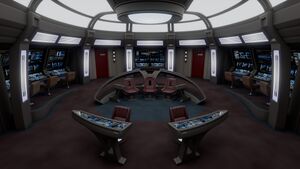
The Main Bridge was also referred to as Asgard. It served as the epicenter for all command decisions made aboard the Valkyrie . The main bridge design purpose of the Valkyrie was to be functional and purposeful.
Like all Starfleet bridge designs, the captain's chair sat in the center of the bridge, to the right sat the executive officer's chair, and to the left an additional command chair usually reserved by the ship's chief counsellor, chief medical officer, or any official or dignitary the Captain sees fit. All three command chairs are made of a deep maroon textile and are surrounded by a metal handrail that encircles the rear half of the central command area.
At the front of the bridge was a wide-angled window that filled the forward bulkhead. This window has holographic projectors built into the rim, allowing it to function as a more traditional viewscreen. It can also be used as an emergency evacuation hatch, with force fields being lowered until replaced by a large, external bulkhead. Directly aft of this were the helm and ops positions. Circling the bridge to the port side was a communications station, science station I and II while on the starboard side were engineering and missions ops I and II. Behind the command circle is the primary tactical and security station. Behind it is the MSD.
There are a total of six ways to enter the bridge. Starting on the forward port side, there is a small alcove that holds access to the captain's ready room and also turbolift two. Aft of that is access to turbolift one, on the starboard side was an entrance to a small corridor that led to the observation lounge. On the forward starboard side was access to an emergency turbolift with access to the battle bridge and main engineering it also provided access to a small head.
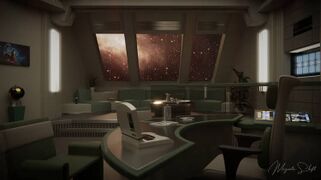
The Valkyrie 's ready room was located on the starboard side of the main bridge. The focal point of the room was the wooden desk that featured a work area and access console, located in front of the main entrance door. A shelf beside the main work desk allowed the commanding officer to display personal belongings such as pictures, or personal items.
A raised level in the front section of the room featured a small table, a curved couch, and a food replicator. The bulkhead behind the couch featured three large windows facing the starboard side of the ship. An aft-facing door beside the main entrance provided access to a head.
Observation Lounge
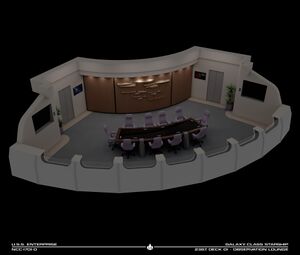
Located aft of the bridge, was the observation lounge aboard the Valkyrie . The lounge serves as a space for the senior staff and other officers to collaborate, celebrate, and make plans for the journey ahead. It connected to the bridge through a short, ramped corridor on the starboard side of the conference lounge. Another door, on the port side of the room, led directly to a turbolift.
The shape of the conference table matched the curvature of the exterior hull, set into the surface of the table were holographic projectors for displaying images and data on the surface of the table or holographic LCARS panes projected at respective eye levels. The table was surrounded by ten chairs upholstered in a deep maroon textile which was also located on the bridge.
Battle Bridge
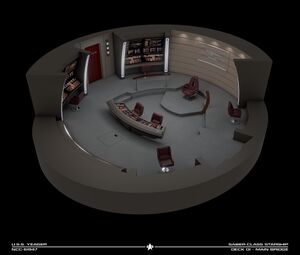
The Battle Bridge was also referred to as a secondary bridge. It was designed to function as a full bridge when in a tactical situation or during saucer separation. The battle bridge is the secondary hull’s bridge.
Odin's Palace
Odin’s Palace was the captain’s mess and lounge located on Deck 05 alongside the captain's quarters, the executive officer's quarters, the executive dining room, and the senior officers' quarters. It was never an overpopulated place reserved for the exclusive use of the ship's senior officers and their guests. Odin’s Palace was designed with a warm, comforting feel appropriate for small gatherings.
The design of Odin’s Palace took heavy influence from that of Nordic / Scandinavian taverns with decorations tying back to the Viking and Scandinavian culture. Wood furnishing with intentionally chosen retro design elements is meant to invoke a sense of ease and relaxation amongst the denizens of Odin’s Palace. Seating is generous with seats found at the bar, in a central common space, and a handful of tables along the outer walls.
Valhalla is the primary social space of the Valkyrie and is located on Deck 15. It was the closest to a ‘no ranks’ space aboard the ship, even though that rule does not exist. Instead, Valhalla operates under the assumption that if a senior officer is present, then they are free to be engaged with any member of the crew.
The decor chosen for Valhalla was to match that of the Nordic / Scandinavian-style lounge and bar. There was usually some sort of mantle to show off a piece of Viking or Scandinavian culture.
It is also a firm rule of Valhalla that the only person aboard a ship who is allowed to declare themselves 'the strongest crewmember' must be the strongest crewmember, as measured by an arm wrestling competition between every worthy opponent. Violators of this rule are refused all service by the wait staff until they have made amends - two mugs of Pale Lager Beer.
Strategic Operations Center (StratOps)
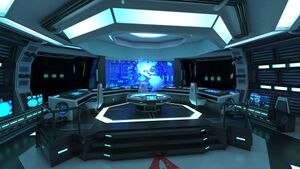
The Strategic Operations Center or StratOps is the primary social space of the Valkyrie and is located on Deck 10. It was installed aboard the Valkyrie at the request of Captain Jackson. The purpose of StratOps was as an information and analysis hub supporting the Valkyrie ’s mission objectives. From StratOps, the crew can have an overview of up to three sectors on the holographic interface and can monitor changes and plan operations. This allows Valkyrie to conduct data gathering and analysis operations across multiple star systems.
With the multi-mission nature of the Valkyrie , StratOps sees extensive use as a mission planning center during diplomatic operations with multiple local concerns, such as security or humanitarian support. This provides operational space away from the bridge and allows the command team to conduct strategic analysis.
Notable Crew
Commanding officers.
- 2401 - Present : Captain Geronimo Fontana
Executive Officers
- 2401 - Present:
- Work in progress
- Sovereign-class
- Fourth Fleet Expeditionary Group
Star Trek: USS Valkyrie
Description.
uss valkyrie
From the heavens to the stars, uss valkyrie – bylaws.
USS VALKYRIE NCC-2590 BYLAWS Section 1: Point of Order
The USS Valkyrie is a Correspondence Chapter (Corry) of STARFLEET (SFI) the International Star Trek Fan Association, Inc., which is a not-for-profit corporation. All of SFI Bylaws, given in the Members Hand Book (MHB) and other policies of STARFLEET are to be observed and suppressed any conflicting Bylaws of either the USS Valkyrie and its Region.
Since the Region is determined by the Region of the current Commanding Officer’s (CO) residence, and the Valkyrie is a Corry with members from various states with in the US as well as members outside of the US, the Valkyrie’s Bylaws that conflict with the current Region’s Bylaws are superseded by the Regions Bylaws.
The USS Valkyrie will have officers as suggested in the MHB. A CO who is also the chapters President, an Executive Officer (XO) who is also the Vice-President of the chapter (see MHB section 3:07), and a Chief of Operations (OPS) as third in command. All three of these positions require that both officer tests: “Officer Training School” (OTS) and “Officer Command College” (OCC) are completed and passed.
There are six distinct levels of service within the chapter:
1) Command; which is held by the CO and XO and are responsible for the representation of the crew to SFI, SFI to the crew, and a fun, cooperative environment that is safe for the crew to express their ideas and opinions regarding anything to do with Star Trek.
2) Department Heads; which is over seen by the OPS and includes Operations, Communications, and Science, it may also include medical, engineering, and any other department that the crew may wish to have.
3) Crew Officers; any member who has past the OTS, and is not in Command nor a Department head. They are free to participate as the wish in any of the departments or not. They may float from task to task as they see fit or sign up for a specific task.
4) Enlisted; these are SFI members who have not taken the OTS, and are free participate as the wish in any of the departments or not. They may float from task to task as they see fit or sign up for a specific task.
5) Yeomen; The Valkyrie recognizes the personal assistant relationship of an officer and enlisted crew member (Yeoman) as being purely voluntary. In general an enlisted member will work closely with an officer regarding anything from a short term project to any time as long as both parties agree. This allows the officer to delegate certain of their positions responsibilities to a single enlisted member to either execute or to like-wise delegate. The Yeoman relationship is a free to serve free to leave cooperative partnership and is created when both parties agree and dissolves as one chooses.
6) Non-members; are simply civilians as it were, just along for the ride. They are those who are not members of SFI. Non-members have no right to vote on the leadership of SFI nor do they have voting privileges in any of the Valkyrie’s leadership roles. They are allowed to participate in all other activities that are not restricted by SFI or the Region.
Section 2: Departments
All responsibilities that are taken on by the Valkyrie’s crew are purely voluntary. However, since SFI is a corporation (regardless of its non-profit standing) there are certain requirements that must be met. The CO is responsible to the body of SFI. The reporting to SFI is done by the CO who can delegate these responsibilities to the XO. The other activities can be delegated to the various Departments.
Operations acts as a liaison between departments and is responsible for ship board elections.
The Communications Department is in charge of making sure the Valkyrie’s newsletter is completed and released quarterly; Spring (May 1), Summer (August 1), Fall (November 1), and Winter (February 1).
The other Departments are to be defined as needed for a smooth running web-site and maintain any other communications networks amongst members, as well as the recruiting of new members and coordinating information about Star Trek activities members maybe interested in participating in, including local SFI meetings, Cons, and fund raisers.
Section 3: Elections and Lack of Confidence Votes
Only SFI members are allowed to vote in any and all elections. All positions of responsibility are subject to appointment or direct elections as well as recall and lack of confidence ballots. OPS is in charge of counting all ballots and the XO verifying with the exception when regarding Lack of Confidence of the OPS position and those votes are counted by the XO and verified by the CO. Any SFI member may write the RC in the event that they believe there has been any ballot tampering.
Every even numbered year a vote is taken to determine if the CO needs to be replaced. A simply one third vote in January (beginning on the first and finalized on the 15th) for a new CO will start the process for the election of a new CO. Any SFI member of the Valkyrie’s crew having past both OTC and OCC test is allowed to run in this election. All ballots and nominations will be e-mailed to the current OPS. Nominations of at least three votes will be placed on the ballot for February 1st and finalized on the 15th. A majority vote (greater than 50%) for one candidate will elect a CO to start at the beginning of the next month. If there is no one with a majority of votes the two (2) highest vote-getters will be in a runoff election with ballots being gathered from March 1 st and finalized on the 15 th. If there is a new CO the new CO will take office on April 1 st.
The CO is responsible for assigning/recruiting for all positions including XO, OPS, the Head of the Communications department, and other department heads. At any time during service any and all of these positions, including the CO, are subject to lack of confidence vote and replacement.
A Lack of Confidence Vote can be initiated when three (3) crew members ( one officer and two enlisted or two officers and one enlisted) feel that it is necessary to replace any crew member from their position. Their petition will be went in to the CO, OX, and OPS. The OPS (or OX if it’s the OPS under question) will send out notifications to all SFI crew members.
After one (1) week the voting will be closed a 2/3 vote indicates an immediate termination of the member in question position and a ballot is with those the CO, OX, and OPS feel are best to fill the opened position. The votes will be tallied after a week and the position filled. If it is a simple majority then nominations are taken over a two (2) week period and the two with the most nominations are placed on the ballots, distributed, and counted two (2) weeks later with any tie decided in conference between the CO, OX, and OPS even if one of these three are being replaced.
Section 4: Disciplinary Actions
As clearly expressed in STARFLEET’s Bylaws and Member’s Handbook any and all illegal activities (as stipulated by the law; international, national, state, or any other municipality cannot be condoned by STARFLEET and should be reported as described in STARFLEETS MHB.
Any and all situations which cannot be worked out between crew members should be brought to the attention of the CO, if the CO is involved the RC of the region should be informed and the investigation will be carried out as the region has stipulated. The CO has a month to discover all the facts on both sides and to inform the parties as to the correcting measures which will be used.
Appeals can be made to the XO and OPS or to the region’s RC within a month of the decision.
The XO and OPS will review the CO information and then investigates what the appealing party has to say and further the investigation for no more than a month and return their verdict. These internal measures should be mentioned in the MSR as to insure clear documentation and just procedures have been taken. Section 5: Awards and Promotions
This is considered to be part of the fun which SFI provides. Awards are available at the STARFLEET level, and besides the officers, the crew should become familiar with these since they are also able to nominate each other for them. Many regions have their own award program as well and the officers and grew should also inform themselves as to these since each award has its own set of qualifications which may inspire them to enhance their SFI experience.
Nomination criteria varies from regions to region and only those stipulated by the region can nominate for these awards. Ship board awards are also encouraged and these are left up to the CO based on the crew’s input as to what is appropriate as well as the officers to either recognize outstanding achievements or encourage healthy competition in various operations of the chapter.
The CO has the final say in whether or not a shipboard award is appropriate and if the designated award committee has chosen wisely on their selection.
Promotions from the chapter are solely given out by the CO up to the O6 category as stipulated by the MHB. The criteria is up to the CO although the crew can put forward any recommendations they have. Section 6: Finances
The CO is responsible for all the chapter’s treasury as stipulate by the MHB and other STARFLEET manuals. Therefore the CO has the right to veto any expenditures, payment processes, and alternative book-keeping before they are put into effect. This veto cannot be overturned although discussion is permitted. If the CO decides to change methods the crew only needs to be informed. The CO is responsible for the books and must include the monthly ledger with the MSR and the Valkyrie’s newsletter as well as the total annual ledger at the end of each year. The only exceptions is in quid-pro-quo (tit-for-tat) that is one member pays for one service. The Communications Officer may send out hard copies of the letter and ask for payment of printing and shipping as long as the payment does not exceed the costs.
The Communications officer is then responsible for the receipts and must send copies to the buying member and to the CO who must note these along with the monthly and annual reportings. STARFLEET is a non-profit organization and any and all monies taken in by the chapter must stay in the chapter to cover expenses. Therefore any charitable giving must be done by the individual members directly to the charity. Since this is a Cory chapter there will not be any fundraising events where monies is taken in as donation as in an event or raffle nor any other situation where money is taken in to be later given to a charity unless there is a three month period of discussion, vote, and charity fund-raiser.
Initially the only expenses that the chapter has is its website, which is now funded by various members from their generosity. If the costs exceed this generosity then the CO may ask the member to either voluntarily send in monies or set a due for membership. This due can be biased against non-SFI members but cannot exceed the needs of the chapter. If new members join or leave the dues will be recalculated the next calendar year. I there is a surplus of more than 10% for the annual outlays then the CO will refund the members who paid in during the fiscal year all equally regardless of when they paid during that year.
If any of these financial procedures fall short of STARFLEET’s or the region’s then STARFLEET’s and the region’s takes precedence.
Section 7: Amendments
Amendments, changes, and corrections may be made to these Bylaws as agreed upon. Simple corrections can be submitted to the CO and if there is no actual change to the running of the Valkyrie then those corrections can be made. If for any reason there is a lack of participation and certain positions and duties have to be carried out these sort of changes should be published for the crew as to needing to happen and why, along with a solicitation for alternative measures. If after a month no other measures have been offered the changes will be foot noted in the appropriate section, dated, and then when the original obligations can be meet the original Bylaw shall be observed and the foot note will reflect when this was done.
As far as amendments go they should be proposed to the CO by either two officers and one enlisted or one officer and two enlisted. These proposals should be presented as they wish them to appear if the amendment is added. The CO as a month to review the amendment and consult with whom the CO wishes. The CO then can suggest changes, corrections, or a completely different amendment and the submitters who then have a month to ask for a vote; either on their original amendment or one of the CO’s suggestions. If they wish to adopt bits and pieces of the suggestions and/or their original amendment they need to rewrite the amendment as they then see it and enter into a dialog with the CO and others as deemed appropriate. This final discussion can last up to two months. If any of these deadlines fail then the presenters can either set the Amendment to ballot or abandon the amendment. The Amendment will be voted on within two months and needs two thirds of all crew members approval to be enacted. The votes will be submitted to OPS and the OX will verify unless either or both OPS and OX helped draft the amendment and the RC will be asked to help with the vote. If the amendment fails it cannot be voted upon again. The CO can “Veto” any new amendments that resemble the failed amendment. These “Vetoed” amendments can be appealed to the OX and OPS and together they can overturn the CO’s veto.
Commander Stephen Halkovic – CO USS Valkyrie January 2015
Share this:
Leave a comment cancel reply.

- Already have a WordPress.com account? Log in now.
- Subscribe Subscribed
- Copy shortlink
- Report this content
- View post in Reader
- Manage subscriptions
- Collapse this bar
USS Valkyrie (NCC-2590)
- Edit source
- View history
The USS Valkyrie (NCC-2590) was a Federation Constellation -class medium cruiser starship commissioned into Starfleet service in 2294 .
Valkyrie 's construction contract, NCC-2590, was ordered in 2288 . ( Orion Press : Constellation -class specifications) The ship was originally scheduled to be named Swiftsure , but was renamed Valkyrie . ( Hobbyist's Guide to the UFP Starfleet , Part 1b)
The ship was constructed at and launched from Copernicus Ship Yards , Luna . She was originally to have been commanded by Captain Lorraine Wilcox. However, shortly before launch, Wilcox was onboard a transport ship near the Metreka Nebula that was attacked and destroyed by Orion pirates. On short notice, Captain Edward Stanfield was transferred from the USS Saratoga to the Valkyrie as her new commanding officer . ( Star Trek: Valkyrie : " New Command ")
The Valkyrie' s engineering pod and nacelles were replaced after only two years in service. An unplanned trip beyond the galactic barrier caused the ship to require the extensive repairs, which were undertaken at Earth Spacedock . Following the work, the ship had a maximum safe emergency speed of warp 9.25 (OCU). ( Star Trek: Valkyrie : " The Inquiry, Part 2 ", " The Primal Directive ").
Valkyrie was one of four starships that rescued the survivors of the USS Potemkin after it was destroyed by Romulan forces in 2299 . ( Project Potemkin : " Destinies ")

Dedication plaque
External links [ ]
- USS Valkyrie article at Memory Alpha , the canon Star Trek wiki.
- USS Valkyrie (NCC-2590) article at Memory Beta , the non-canon Star Trek wiki.
- Orion Press : Constellation -class specifications PDF file
- 1 USS Enterprise (NCC-1701-G) (Excalibur class)
- 2 USS Enterprise (NCC-1701-H) (Endurance class)
- 3 Dominion War

Constellation class
- View history
The Constellation -class starship was a type of Federation star cruiser employed by Starfleet from the late 23rd century through the late 24th century .
- 2.2 Propulsion systems
- 3.1 Main bridge
- 3.2 Main engineering
- 3.3 Crew cabins
- 4 Ships commissioned
- 5.1 Appearances
- 5.2.1 Studio model
- 5.2.2 The Magazine
- 5.3 External links
History [ ]
The Constellation -class began service as early as 2278 , when the USS Constellation appeared on a Starship Mission Assignments chart on the bridge of the USS Bozeman after exiting a temporal causality loop . ( TNG : " Cause And Effect ")
The USS Hathaway , was constructed in 2285 at Yoyodyne Propulsion Systems at the Copernicus Ship Yards on Luna . ( USS Hathaway dedication plaque )
Nearly a decade after the launch of the Hathaway , the prototype for the class, the USS Constellation , was still undergoing certification trials. ( Star Trek VI: The Undiscovered Country Operation Retrieve chart )
Four decades later, Starfleet continued to launch new ships of this class, including the USS Stargazer . ( PIC : " The Star Gazer " commemorative plaque )
During the early-to-mid 24th century, the Constellation -class was noted for performing both deep-space exploration and defensive-patrol duties. ( TNG : " The Battle ", " The Wounded ")
By the mid- 2360s , this class of "old-style" star cruiser was on the fringe of being phased out of the fleet. Those that had been decommissioned , including the eighty-year-old Hathaway , were stripped of their offensive systems and rendered "warp inactive," which included the removal of all antimatter . ( TNG : " Peak Performance ")
Those that remained in service were typically relegated to transport duties. ( TNG : " Elementary, Dear Data ") Constellation -class starships were also used in second-line service, including the hastily-organized Federation blockade during the Klingon Civil War , and later participated in the Dominion War in 2374 . ( TNG : " Redemption II "; ( DS9 : " In the Pale Moonlight " okudagram )
Technical data [ ]
A ship of this class could be manned with a crew of forty. ( TNG : " Peak Performance ")
Propulsion systems [ ]
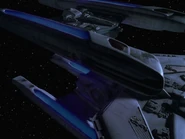
One notable feature of the Constellation -class was that it was outfitted with four warp nacelles . ( TNG : " Peak Performance "), et al.) The Constellation -class had a maximum speed of warp 9 . ( TNG : " The Battle ")
During their original construction, Constellation -class starships employed Avidyne engines . By the latter 24th century, these had been replaced with more effective engines. ( TNG : " Peak Performance ") These starships had at least two impulse reactors . ( TNG-R : " The Battle ")
In 2369 , Captain Jean-Luc Picard , commander of the Galaxy -class USS Enterprise -D regarded his former command, the Constellation -class USS Stargazer as being " an overworked, underpowered vessel that was always on the verge of flying apart at the seams, " adding, " in every measurable way, my Enterprise is far superior. " However, he did admit that there were days when he would've done anything to be back aboard the Stargazer . ( TNG : " Relics ")
Interior design [ ]
Main bridge [ ].
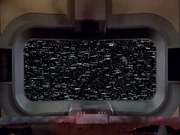
Main viewscreen
Although the layout of the main bridge of the Constellation -class of starships could be described as "standard" in terms of how Federation starship bridges are designed, the Constellation -class appeared to have two prominently different bridge types. These variations can be recognized between the USS Hathaway , launched in 2285 , and the USS Stargazer , last active in 2355 .
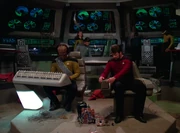
Bridge of the USS Hathaway
The Hathaway -type bridge had an unusual arrangement, with front of the bridge relatively wide open and the primary stations cramped in the rear of the bridge.
The helm and navigation stations were located on the extreme port and starboard sides of the ship with the captain's chair near the center of the bridge. This gave the captain an unobstructed view of the viewscreen located at the front of the bridge. Next to the captain's chair, set less than a meter back and off to the right, was the first officer 's chair with console.
Directly behind the command chairs was the tactical station , with the engineering station to the far rear (on the port side) and science station to the far rear (starboard side). In front of the engineering station was an entryway to the bridge entryway. ( TNG : " Peak Performance ")

Bridge of the USS Stargazer
Described as a "cramped little bridge" by Picard , the Stargazer -type was actually less cluttered than the Hathaway -type, with a design more reminiscent of the Constitution II -class - or Ambassador -class bridge. ( TNG : " Relics ")
In the front was the viewscreen, with side-by-side helm and navigator consoles, a feature that noticeably contrasts that of the Hathaway -type. The captain's chair was directly aft the aforementioned stations; no accommodations were present for the first officer in this type.
At the rear of the bridge, a tactical station was found on the far left with monitors along the back wall behind the captain's chair, with a second primary station located on the opposite side of the bridge. The primary stations were attached to the rear wall of the bridge, support railing partially enclosed that section from the front of the bridge. On either side of the rear wall monitors and between either primary station were two turbolifts . Along the port wall, directly to the left of the captain's chair and between the tactical station and the viewscreen, was the entryway to the captain's ready room . ( TNG : " The Battle ")
Main engineering [ ]
Main engineering was where the ship's power systems were controlled and was the home of the ship's antimatter warp drive chamber and impulse engine controls. ( TNG : " Peak Performance ")
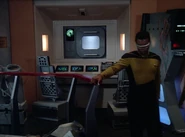
Crew cabins [ ]
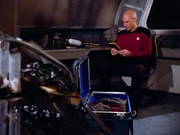
Picard's quarters
Cabins aboard Constellation -class starships were of typical design associated with Federation starship of the era, providing spartan accommodations for the crew. ( TNG : " The Battle ")
Ships commissioned [ ]
- USS Constance (NCC-10367)
- USS Constellation ( NX -1974)
- USS Hathaway ( NCC -2593)
- USS Stargazer (NCC-2893)
- USS Victory (NCC-9754)
- USS Gettysburg
- USS Magellan
Appendices [ ]
Appearances [ ].
- " The Battle " ( Season 1 )
- " Elementary, Dear Data " ( Season 2 )
- " Peak Performance "
- " Redemption II " ( Season 5 )
- End credits sequence (display graphic) ( Season 3 )
- " The Star Gazer " (display model and graphic)
- " The Next Generation " (display graphic)
- " The Bounty "
- " Reflections " ( model ) ( Season 3 )
- " I Have No Bones Yet I Must Flee " (model) ( Season 4 )
Background information [ ]
The first Constellation -class ship seen, the Stargazer , was originally planned to be a Constitution II -class ship, allowing the visual effects staff of Star Trek: The Next Generation to make use of the existing movie USS Enterprise -A model. Actually, the producers did not make the decision to build a new, full-scale filming, or studio model , of the Stargazer until after the episode was filmed with both Wil Wheaton and LeVar Burton calling it a Constitution . The choice of the name "Constellation" was based largely on the fact that it could be dubbed over La Forge's line since the two words are so similar. ( Star Trek: The Next Generation Companion (3rd ed., p. 41); Star Trek Encyclopedia (4th ed., vol. 1, p. 158))
In Vonda N. McIntyre 's novelization of Star Trek III: The Search for Spock , the USS Enterprise is referred to as a Constellation -class starship instead of Constitution -class.
Studio model [ ]
The magazine [ ].
A Starfleet Technical Database -article appearing in Star Trek: The Magazine Volume 3, Issue 9 that was later written by designer-creator Rick Sternbach stated that this class of ship had fifteen decks and a crew complement of 535 and that the class consisted of eight vessels (including the USS Gettysburg and USS Magellan ). In addition to the aforementioned, the article also stated that a USS Valkyrie ( β ) (NCC-2590) and a USS Gihlan ( β ) (NCC-9761) existed, the latter named after an admiral who oversaw the development of Constellation -class starships. The class's mission statements were: long-range sensor analysis within threat territories, communications, intelligence gathering, deployment and retrieval of cargo and stealth shuttles, general science and patrol duties.
External links [ ]
- Constellation class at Memory Beta , the wiki for licensed Star Trek works
- Staff picks
- Downloadable
- Collections
- Community members
- Sketchfab Masters
- Animals & Pets
- Architecture
- Art & Abstract
- Cars & Vehicles
- Characters & Creatures
- Cultural Heritage & History
- Electronics & Gadgets
- Fashion & Style
- Food & Drink
- Furniture & Home
- Nature & Plants
- News & Politics
- Places & Travel
- Science & Technology
- Sports & Fitness
- Weapons & Military
- Best selling
- 3D Printable
- For business Sketchfab for Teams Augmented Reality 3D Viewer 3D eCommerce 3D Configurators Find a Partner Pricing Customer Stories
USS Valkyrie (Star Trek) 3D Model
The Valkyrie’s pretty much the same type of spaceship as the USS Franklin from Star Trek Beyond (expect in better shape and brand new, haha). Took me 5 weeks to do on and off, with a lot of tweaking, texturing, and baking. But I’m happy with the result!
- Cars & vehicles 3D Models
- Electronics & gadgets 3D Models
- ussfranklin

AC-409 Mk III Valkyrie
From star trek: theurgy wiki.
These were the prototype warp fighters commissioned to the USS Theurgy at the end of the 24 th century. There were originally 16 warp fighters on the Theurgy , and they were flown by the Lone-Wolves squadron.
As the war against the parasites that usurped political power in the Federation raged, many of the Lone-Wolves were KIA. With the destruction of their fighters, the availability of the Mk III was diminished. This was until the Theurgy obtained a few more at the Black Opal Weapons Facility at the end of March in 2381.
- 1 Fighter Demonstration 01
- 2 Fighter Demonstration 02
- 3 Production History
- 4.1 - Twin Mount Turrets
- 4.2 - ECM Pod/ECCM Emitter
- 4.3.1 - Torpedo Launchers
- 4.3.2 - External Micro Torpedo Launchers
- 4.4.1 - Mk XXVII Photon Torpedo
- 4.4.2 - EMP Torpedo
- 4.4.3 - Mk Q-II Quantum Torpedo
- 4.5.1 - Mk I Hellbore Torpedo
- 4.5.2 - Mk I Hellhound Cluster Bomb
- 5 3D Demo: Warp Fighter Weapon Systems
- 6.1 Primary Firing Mode
- 6.2 Secondary Firing Mode
- 7.1 Advantages
- 7.2 Disadvantages
- 8.1 Escape Pod
- 8.2 ETS (Emergency Transport System)
Fighter Demonstration 01
Fighter demonstration 02.
Production History
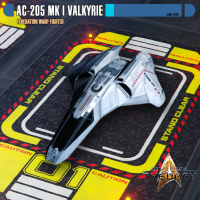
The formation of the Starfleet Astronautical Command Division was heavily influenced by the successful deployment of Peregrine -class fighters aboard the starships serving as carriers in the fleet. The year 2375 - after the conclusion of the Dominion War - the AC-205 Mk I Valkyries were deployed. These fighters were assigned to the USS Typhon (TNG game: Star Trek: Invasion). They were initially designed as a carrier-based fleet engagement craft. The design proved successful, with a high survivability rate matching the heavy fire power available to bring down larger ships. In learning that a full squadron of Valkyries would still require a lot of support from for engagements of a Dominion-War level threat, Starfleet deemed that the attack fighter needed an upgrade (By 2381, the Mk I fighters were still being deployed in fairly limited numbers - shuffled around the fleet).
Another development at the time was that a group of influential admirals in the fleet demanded to form a new division that hand-picked the Conn officers with the most tactical training. It was the only way, they reckoned, to ensure that the fleet used the right kind of pilots for the Valkyrie Program. The original score of 400 personnel - the fleets new Tactical CONN officers - served as the foundation for a new and more organised department for fighter pilots. They accepted only the highest scoring CONN or fight-trained Security or Tactical Cadets, and then dealt them another year of training in the fields they lacked from their Academy training. White became the chosen colour for the [[ Starfleet Astronautical Command ]] Division, and the admirals that rode this project into history became the core of the Aerospace Command.
Both the Mk I and II Valkyries used Rear Intercept Officers (RIOs). The efficiency in which the attack fighters were operated were doubled by allowing the pilots to focus solely on the manoeuvres and weapons employment of the craft during a fight, allowing the RIO to handle comm traffic, emergency repairs and tactic simulations. Among the improvements for the Mk II Valkyrie were a new ablative armour compound, improved power plant, and the employment of a hardpoint system beneath the wings. With the Mk II, the Valkyrie truly stepped into a class of her own.
The Mk II's Type U+ cannons worked on the same principles as the Type U on the Defiant-class starships, but at a much smaller scale as well as 20 % reduced output. The first iteration of the U+ could be seen on either side of the MkII 's fuselage, but a second version was later made to be wing-mounted on the AC-409 Mk III Valkyrie (it was the same technology in both versions of the U+ cannons, only on the Mk III , the entire weapon system was mounted on the wings instead of being inside the fuselage of the fighter (as it is in the Mk II ).
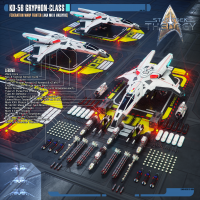
At the success of the Mk II and the fleet-wide deployment of the Valkyries in the fleet, Starfleet Command began looking into the Valkyrie with more interest. So when the project was given new resources, R&D went back to the drawing board to see what could be improved on an already formidable weapon in a MK III version.
The first step was to increase the command, control, and reconnaissance capabilities of the design. Originally, the Valkyrie (both Mk I and Mk II) employed an isolinear twin-core design computer system, with 372 isolinear banks and 106 command pre-processors and data analysis units. This design was quite successful for the use of standard comm traffic control and tactical targeting, but newer sensor package upgrades intended for the Valkyrie were hampered by a core that was already at its limit for processing power. So, with the eagerness of little boys with a new toy to take apart, R&D - under the direct involvement of Director Rennan Cooper - they began to work on the third iteration of the Valkyrie warp fighter.
By that time, Hyperjet Quantite Mk IV reactor cores were being successfully implemented in the experimental Knight-class Mk I Interceptor. These core types could be sized variably (depending on the design requirements) while still maintaining a very high energy output. A twin-core design was drafted for the new Mk III, and projected numbers suggested the Mk III would see a 25% increase to power output than the Mk I & II series. With this increase in power output, a larger computer core system was designed. Utilizing bio-neural processors and relays, the original frame space needed for the computer systems was reduced and spread out through the center-line of the craft. Computational capacity and storage was increased by another 30%, and a new tactical link-up library software system was implemented. The system provided a clearer and more accurate battlefield image for the pilot, and the integration was so effective that the RIOs were no longer needed - only one pilot was required in the cockpit.
With this new freedom of space within the spacecraft hull, R&D decided a more streamlined hull would benefit the pilot. Their new, sportier look reduced sensor cross-section and improved warp field stability for the twin quantite reactor cores. With the hull redesign came minor changes to weapons load-out: the arrangement of the Type U+ pulse phaser cannons, while the technology was the same as the Mk II, as an upgrade, the warp drive plasma conduit ran through the primary phaser coupling to double the power of the Mk III ’s phaser cannons. There were pulse or beam firing options available and bolts had a firing rate of 5 per second. The beam setting had lower yield but longer range. The microtorpedo launchers in the Mk II changed only slightly to fit into the new spaceframe. The hard-point system was simplified, and the pulse phaser cell-magazine rack was switched from a vertical feed system to a horizontal feed system – this to combat original design flaws and jams during gravity-inducing combat maneuvers.
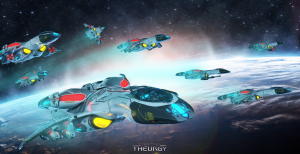
Lastly, one more weapon was added: a tetryon pulse phase cannon was installed on the underside of the cockpit within its own hull compartment. This cannon was installed for ground suppression roles, and to give the Valkyrie an added punch in the Space Superiority role. The drawback to the tetryon pulse phase cannon was its limited ammunition and craft maneuverability when utilizing the weapon. Though the weapon itself could effectively neutralize enemy engines and weapons systems, as well as do considerable kinetic energy damage, the weapon itself failed at a remarkable rate when engaged in combat maneuvers. A straight-line course was required for the weapon to work effectively, limiting it to the dangerous Head-to-Head combat maneuvers, and strafing of ground or orbital targets. With these weapon enhancements and increase in power, a slightly larger pair of shield generators were installed, increasing shield sustainable load to 390 isotons/second. It was also given parametallic plating over and the ablative armor was thickened from 10.7 cm to 11.1 cm.
The top speed and warp capabilities of the Mk III remained virtually unchanged, but the increased power output from the new quantite cores benefited the improved avionics, sensor, weapons, and shield systems more than her speed. Despite this, the Valkyrie Mk III could easily go toe-to-toe with the fastest Interceptors currently in service. What she lacked in speed, she made up for in raw firepower.
As of 2381, the Mk III Valkyrie remained a prototype test model, but with the recent development in intergalactic politics and the potential Romulan threat, the project was pushed towards immediate deployment by Aerospace Command. So, since the new Theurgy -class starship - the USS Theurgy - was not only being fitted with an A.I. interface, but with a fully operational (if small) fighter assault bay, the decision was made. The Theurgy was given a complement of sixteen Mk III fighters with their own Squadron Commanding Officer and a crew of thirty technicians hailing from Starfleet Operations or Engineering Corps.
The sixteen pilots were named the Lone-Wolves, and though decimated to only twelve pilots after their escape from Earth, the survivors kept fighting to preserve the truth of the corrupted Starfleet Command .
Tactical Systems
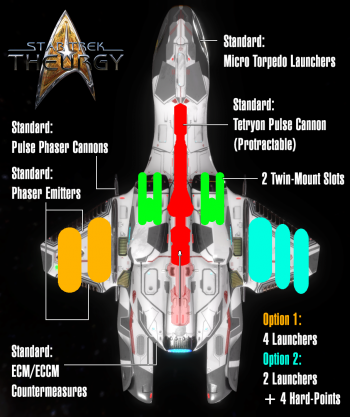
The Mk III Valkyrie had two different hard point configurations, as shown in the image on the right.
Besides the phasers , which was a standard technology, other warp fighter tactical systems can be found below:
- Twin Mount Turrets

Twin Dual Cannon guns utilizing an ammunition replicator to create 30 mm Osmiridum shells. These shells were suspended in a small warp field bubble to render them nearly weightless before being electromagnetically propelled at a speed near mach 15 with a rate of up to 1000 rounds per minute, assuming all four cannons were being fired. Devastating against soft targets as well as being effective against armors of nearly all types, it was however, ineffective against shields, and its projectiles could be easily reflected via standard deflector arrays. The weapon could be placed in a fixed forward position or could be set to automatically track subsonic targets for fire, though it proved to be ineffective at automatically tracking fast moving small targets. It could hit large targets moving at high speeds but not with the same precision as expected with slow or fixed targets. Designed for aerial and suborbital assault on non-shielded Terrestrial targets, deep space strikes against bases, and aerial support of ground operations ( see below for more information ).
- ECM Pod/ECCM Emitter

Counter measures. These were not options but loaded into the aft of the fuselage as standard. ECM (Electric Counter Measure) was essentially a micro torpedo full of shrapnel and debris with the given craft's transponder signature and sensor reading. It confused the enemy ordinance and caused it to think the cloud of debris was the target. ECCM (Electric Chemical Counter Measure) created a wake similar to a warp, impulse, or thruster engine's wake, fooling such a guided missile into a false lock.
There were two kinds of launchers that could be mounted underneath the wings of these fighters, one for standard torpedoes and one for micro-torpedoes.
- Torpedo Launchers

Additional, wing-mounted torpedo launchers that can hold 3 photon torpedoes, EMP torpedoes or Quantum Torpedoes in any kind of combination. It was recommended to mount two of these in order to balance the fighter properly. This meant that the hard-point option of additional torpedo launchers held 6 torpedoes when the Valkyrie was deployed into battle.
- External Micro Torpedo Launchers

Additional, wing-mounted micro torpedo launchers that can hold either 56 Mk II micro photon torpedoes. It was recommended to mount two of these in order to balance the fighter properly. This meant that the hard-point option of additional micro torpedo launchers held 112 additional micro photon torpedoes in total when the Valkyrie was deployed into battle to complement those that the Valkyrie itself already had as standard internal armament.
Standard Torpedoes
These kinds of torpedoes were loaded into the torpedo launchers.
- Mk XXVII Photon Torpedo

Standard photon torpedo ordinance. The explosion was a matter-antimatter reaction producing large amounts of gamma waves as its primary means of destruction. While smaller in size, and harder to target mid-flight, each torpedo had the approximate yield of 70% compared to the Mk IV (the kind that Federation starships launched from their torpedo bays). This torpedo was deployed in the wing-mounted additional torpedo launchers (see above).
- EMP Torpedo

Created the electromagnetic pulse similar to what was created from the high atmosphere detonation of a nuclear warhead. A well-shielded craft would withstand this easily but the weapon would detonate in a burst of broadband, high-intensity electromagnetic energy, capable of disrupting magnetic fields and producing current or voltage surges in conductive materials via magnetic induction. Indirect damage to enemy hardware often proved substantial, and while it had a greater chance of disabling a small craft, the plasma surges could wound or kill soft targets if they were directly exposed.
- Mk Q-II Quantum Torpedo

An improvement of the Mk XXV photon torpedo with a higher yield, comparable to that of photon torpedo mounted on Federation Starships. This was a tactical quantum weapon, that utilized a plasma warhead and casings similar in shape to photon torpedoes. The explosion left an antimatter residue and although they were powerful weapons, even a direct hit from a quantum torpedo might not destroy neutronium alloyed targets.
Hard-Points
- mk i hellbore torpedo.

An experimental weapon that grew out of historic tandem-charge armour-penetrating designs. Attempting to achieve similar function from contemporary photon and quantum warheads was pointless; the detonation of the first would obliterate the second too early, and a submunition method was less effective than simply firing two torpedoes. Advances in material science led to a way to produce neutronium in small quantities - fashioned into a penetrator cap and coupled to a small subspace field generator, and driven by a single-burn impulse unit whose size belied its power, the nose of the missile could tear its way through alloys with even the strongest of structural integrity field enhancements, allowing the oversized antimatter warhead in the belly of the torpedo to detonate well inside the defensive screens of its target. Due to the projectile's large size and slower speed compared to the smaller conventional torpedoes, the penetrator cap was ineffective against shielded targets and was best deployed against unprotected hulls. However, the yield was heavy enough to cause severe damage to shields nonetheless.
- Mk I Hellhound Cluster Bomb

Similar in nature to the photon torpedo, this was a photon torpedo filled with several micro torpedoes. Once the torpedo came in contact with an enemy or a surface, it detonated and fragmented into smaller torpedoes, which spread from the point of impact, also exploding on impact, resulting in a large pattern of torpedo detonations. Deployed correctly, this hard-point had the potential to cause severe damage when scattered upon enemy shields on impact. The torpedo snapped open by spring-force, and both the arming and the fuse was pilot-controlled by either manual or automatic settings. It could be armed prior to discharge or scattered by manual command.
3D Demo: Warp Fighter Weapon Systems
Type i tetryon pulse phase cannon.
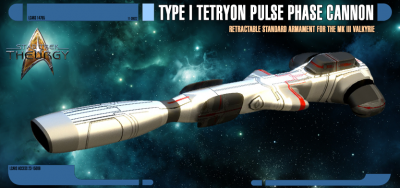
This was an advanced weapon system with two forms of fire. First was a form of a pulse phaser cannon that fired small concentrated tetryon pulses to mark a target. Once marked, the cannon then fired a concentrated phaser shot to cause damage similar to a Starship’s pulse phasers. Its second form of fire was a large concentrated tetryon pulse. This pulse was capable of weakening shields or disabling computerized systems, allowing for the ability to capture vessels without causing major structural damage.
Primary Firing Mode
Once fired, a thin, constant beam of tetryon particles was fired at the target. This stream painted the target for fire, making it easy for further targeting. After painting the target, the canon made minor adjustments to its aim and fired its primary weapon, a charged pulse phaser blast. This pulse phaser blast was stronger than the typical phase bursts from the wing-mounted pulse phasers and was more comparable to the pulse phaser cannons on a Defiant -class Starship.
A useful benefit to this weapon was how the telemetry data from the tetryon could be linked to other ships in the squadron or with other Starfleet vessels engaged in a battle. This effectively painted the target for all allied ships in an operation. With that ability, precision targeting by all forces became possible.
Using a squadron of fighters equipped with tetryon canons linked to a heavy weapons emplacement was shown to be an effective defense against cloaked warships. This was because all it took was for one fighter to spot the cloaked vessel by bouncing a tetryon pulse off of it. Once that was done, the signal could be sent to all other fighters and weapons emplacements to fire on the location of the cloaked ship.
Secondary Firing Mode
In this mode, the tetryon cannon fired a concentrated tetryon pulse. The ability of tetryon pulses to cause equipment malfunctions was proven time and again, so it made perfect sense to weaponize this trait. When the concentrated tetryon pulse impacted against a ship’s shields, the tetryon particles tended to weaken the shield bubble, creating a temporary weak point in the shield's systems. This could allow for another ship in formation to fire a more conventional weapon at the weak point, allowing for greater shield penetration than otherwise possible. Often, in order to use this “one-two punch” method of attack, the element leader would be the one using the Tetryon pulse cannon while his wingman followed up with a conventional attack.
While the tetryon Pulse was effective as a means of weakening shields, its greatest asset was revealed when used against a target rendered without shielding. When the particles impacted with a surface, they tended to penetrate through metal surfaces and pass through most armors, affecting whatever computerized systems were in the area near the impact of the pulse. The tetryon particles wreaked havoc on most computer systems, effectively disabling the systems in the affected area.
M-142 RF Mass Driver Twin Mount Turrets
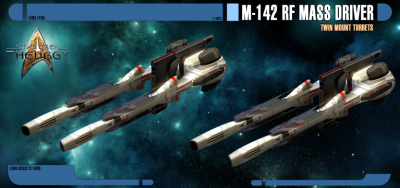
The M-142 RF Mass Driver Twin Mount was a set of two dual-mass driver semi-automated turrets. These lethal devices were hard-point mounted on the undersides of the impulse drives, and in their default position they faced forward. Aimed similar to the micro-torpedo launchers and pulse phaser cannons on the Valkyrie, the targeting sensors' arc of fire could track and follow targets in an almost hemispherical firing arc. While the tracking systems were unable to effectively track and hit small agile targets like Shuttles Fighters and small auxiliary craft, it was effective at striking large targets, like starships, and could strike with pinpoint accuracy on stationary or slow moving targets such as Starbases, ground installations, or subsonic moving targets such as ground transports.
The nature of the weapon was less a conventional gun and in fact had far more in common with the tubes used to fire torpedoes on a starship, combined with the warp field bubble projectors used on the Valkyrie itself. By interfacing through the ship's power regulation systems the stardrive of the Valkyrie sent the necessary power to create a warp field bubble within the barrels of the weapon. This short lasting warp field formed around a 30 mm Osmiridium shell created via the weapon systems onboard replicator. Now virtually weightless, even near high G environments like outer atmospheres of Gas giants, the shell was pushed through a magnetic field coil, reaching speeds of Mach 15. Capable of a rate of fire of 250 Rounds per minute per barrel (a little over four rounds per second), with all barrels firing this allowed for a total of 1000 rounds per minute.
Its primary role in combat was not for space superiority (Fighter to fighter) warfare but as a means of aerial or orbital support for ground combatants. It was also quite suitable for pinpoint strikes on starbases or capital ships after their shields had been dealt with. With the correct sensor configurations, this weapon could also target via remote detection of tetryon reflection. This allowed a ground operative with a tetryon targeting based weapon to be used as a remote targeting system. These pulses could then be interpreted as a target by the turrets systems, allowing for ground units to effectively paint targets via tetryon pulse for a precision aerial strike. This added a 4th function to the Accipiter as its tetryon pulse systems could be used as a targeting system for the Twin mounts or any of the Valkyrie's other weapons systems.
- Excellent at providing air support for ground operations .
- High rate of fire.
- Effective against conventional, energy reflecting, or ablative armors.
- Devastatingly effective against soft targets.
- Large targeting arc (360 degree rotational arc covering Forward, Aft, Port, and Starboard) with 15 to 66 degree ventral targeting arc.
- Could be set to fixed forward position.
- Cannons could be set to staggered bursts (4 barrels each fire in a sequence one at a time in a burst of fire) or in a 4 cannon Blast (all 4 fire at once in a single blast)
- When in forward position, it could be potentially devastating against other fighters if their shields had been taken down, providing the pilot could get a solid lock against their target. At close ranges or in atmosphere it could also be an effective close range dog-fighting weapons system similar to the use of guns on a real life jet fighter.
Disadvantages
- Maneuverability is slightly reduced
- These weapons are horribly ineffective against shielded targets.
- The Twin Mounts are rendered completely ineffective if fired in the arc of a ship's deflector array. Attacking the forward of a Starship with them was absolutely useless unless the deflector dish is inoperative.
- If damaged, there could be power loss from the engine systems.
- If severely damaged, there can be small scale localized warp core breach-like effects. Potentially sufficient to cause catastrophic failure of Impulse and stardrive systems up to and including a full scale warp core breech.
- The auto targeting systems were unable to effectively track agile small targets effectively.
- Twin Mounts have absolutely no ability to target above the fighter's "Horizon”, meaning there is no dorsal arc of fire.
- To be of use in a dog fighting scenario, the pilot has to be able to fly very well and get a manual target lock without any aiming corrections like with phasers or torpedoes.
In the future that brought the Calamity -project to life, this system was improved on so heavily that the replicator, power supply, warp bubble generator, and rail gun firing system were able to be scaled down into a large rifle. The culmination of this research and progress was the RG-TR1506 Accipiter . The Accipiter used a rail gun operation while the Twin Mount's propulsion was a gauss gun based system.
Ejection Systems
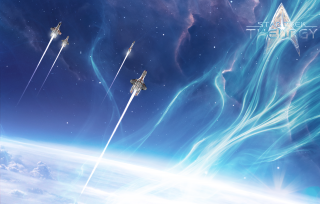
All Valkyries were equipped with ejection modules or "pods". These allowed for rapid emergency egress from the vehicle in case of danger. Linked to dedicated high speed processors, automatic sensors could detect certain types of danger and initiate an eject sequence automatically. This was especially useful if the pilot had been rendered unconscious through a blackout or other injury and the vehicle was in danger of crashing.
Modules had self-righting mechanisms in their base to ensure a correct orientation during landing. Landing was accomplished by a single use anti-grav module. Free falling until they were 3 meters from the ground, the ejection seat/pod activated the AG module, which burned out as it landed the unit (relatively) gently. The pod remained pressurized with approximately 20 minutes of air, allowing a pilot time to completely seal his suit and activate his personal survival equipment. Once ready, the pilot had the option of discarding the pod by activating a manual release.
ETS (Emergency Transport System)
By the late 24th century, emergency transport was further improved through Starfleet 's development of a single-person, single-use, one-way emergency transport unit. The device was small enough to be hand-held and could transport to specified coordinates with a single touch. Because of its extreme limitations, this device was not widely deployed and was still considered a prototype in 2379. [see Star Trek: Nemesis]
The Valkyries have built-in Emergency Transport Systems (ETS) in the cockpit - not the small prototype version - designated to the pilot and worn gear alone, with a one-way pre-set location for the USS Theurgy . The Emergency transporter could be reprogrammed to send the pilot to a new location (chosen by the pilot) because of the possibility of long-range missions, but this system was best utilized in the event of defending the Theurgy - being within Transporter range.
- Technical Specifications
- Fighters & Shuttles
- Fighters & Shuttles Specifications
Memory Beta, non-canon Star Trek Wiki
A friendly reminder regarding spoilers ! At present the expanded Trek universe is in a period of major upheaval with the continuations of Discovery and Prodigy , the advent of new eras in gaming with the Star Trek Adventures RPG , Star Trek: Infinite and Star Trek Online , as well as other post-57th Anniversary publications such as the ongoing IDW Star Trek comic and spin-off Star Trek: Defiant . Therefore, please be courteous to other users who may not be aware of current developments by using the {{ spoiler }}, {{ spoilers }} OR {{ majorspoiler }} tags when adding new information from sources less than six months old (even if it is minor info). Also, please do not include details in the summary bar when editing pages and do not anticipate making additions relating to sources not yet in release. THANK YOU
- Constellation class starships
- 24th century Federation starships
USS Valkyrie (NCC-2590)
- View history
The USS Valkyrie (NCC-2590) was a Constellation -class Federation starship in service in the 24th century . ( TNG episode : " Redemption II ")
Appendices [ ]
Connections [ ].
- 1 Ferengi Rules of Acquisition
- 2 The Chase
- 3 Preserver (race)

Main Page | About | Help | FAQ | Create account | Log in
- Command Staff
- Fleet History & Map
- Mission Statement
- Sim Listings
- Open Positions Search
- Fleet Documents
- Ship Specifications
- Fleet Awards
- JAG Case Archives
- Player Application
- CO Application
- Sim Application
- Instructor App
- Hosting Application
- Federation starship classes
Valkyrie Class
The Valkyrie -class starship was a Federation long-range command carrier vessel that first entered service during the latter half of the twenty-fourth century (c. 2393) as a large, mobile command platform capable of supporting Starfleet operations in unstable or otherwise dangerous situations. Because of the enormous resource cost as well as the potential diplomatic concerns, only one Valkyrie -class dreadnought has ever been constructed and placed into active service.
The origins of the Valkyrie-class starship can be traced back to the early 2380s. Some among the leadership believed the emphasis on smaller, more specialized vessels had left gaps in Starfleet’s ability to adequately field the necessary resources to support largerscale operations. Experiences from the Cardassian Reconstruction as well as the USS Enterprise’s encounter with the Scimitar appeared to justify their concerns that something more was needed.
They called upon Starfleet engineers to develop a new design capable of serving as a mobile command platform. Not only did the vessel have to deploy relatively quickly to politically or logistically unstable environments, it had to have the ability to operate on location for extended periods of time before redeploying again to a new location just as effectively. It also needed to be able to support various operations including peacekeeping missions, combat and enforcement, diplomatic negotiations, and large-scale relief efforts.
Construction of the prototype USS Valkyrie began in 2386 at the Utopia Planetia Fleet Yards. It was the largest starship construction project ever undertaken by Starfleet engineers to date. In fact, the Valkyrie was so large, engineers ended up having to incorporate many approaches and techniques often used when building starbases.
Engineers encountered several logistical delays during the construction process, many of which were due to the vessel’s enormous size. Key systems were expanded, duplicated, or completely reimagined to accommodate the ship’s needs. Even some of the more “ordinary” systems such as turbolifts could not be taken wholesale from traditional practices and had to be adapted along the way. This question of intra-ship transportation presented an issue that was eventually solved by employing a three-tier system of standard turbolifts, high-speed turbolifts, and hardline site-to-site transporter systems to help personnel move about the ship.
Official trials were conducted starting in mid-2390. These demonstrated many of the strengths of the new design, but they also revealed several shortcomings. Engineers were forced to revisit the power distribution systems multiple times to adjust for sudden drop-offs. They also redesigned the defensive systems by adding several more point-defence turrets to provide the Valkyrie with additional protection. The first completed Valkyrie-class vessel was finally deployed to the field in 2393. Due to the incredible resource costs as well as the potential diplomatic concerns of fielding such a large vessel, production has been limited to only the initial prototype USS Valkyrie. It is unknown at this time whether a smaller, more efficient version of the vessel that addresses these concerns will be developed.
Starships Commissioned
Navigation menu.
- Fleet Homepage
- Fleet Forum
- Recent changes
- Random page
- Page Templates
fleet structure
- Task Forces
- Member Starships
- Member Starbases
fleet documents
- Constitution
- Standing Orders
- Executive Orders
wiki portals
- Society & Culture
- Simulations
- Simming Positions
- Crew Application
- Command Application
- What links here
- Related changes
- Special pages
- Printable version
- Permanent link
- Page information

COMMENTS
The USS Valkyrie (NCC-74877) was a Sovereign-class Federation starship in service to Starfleet during the early 25th century. In 2401, the Valkyrie joined a Starfleet armada assembled to confront the massive Singularity that emerged from a spatial anomaly. The ship was briefly compromised when the Borg Queen began assimilating the USS Stargazer and obtained its command codes. (PIC: "The Star ...
The Valkyrie in 2401. In the year 2401, the USS Stargazer investigated a spatial anomaly discovered by the USS Avalon. When a massive Borg ship emerged from the anomaly, the Valkyrie was part of the armada Starfleet built up to reinforce the Stargazer and Admiral Jean-Luc Picard. When the Borg Queen boarded the Stargazer, the Borg Collective ...
The USS Valkyrie NCC-74877 was commissioned in 2373 at Utopia Planitia. The ship underwent a shakedown cruise under the command of Captain Voss on the 12 February, 2373. ... Bravo Fleet is one of the world's largest and oldest Star Trek fan communities. For the past 20+ years, we've provided Star Trek fans a home to write stories throughout ...
The USS Valkyrie NCC-74877 was a Sovereign-class Federation starship in service during the early 25th century. In 2401, the Valkyrie joined a Starfleet armada assembled to confront an unknown Borg vessel that emerged from a spatial anomaly. The ship was briefly compromised when the Borg Queen began assimilating the USS Stargazer and obtained its command codes. (PIC: "The Star Gazer") USS ...
The USS Valkyrie (NCC-68816) was a 24th century Federation starship, a Paladin-class vessel in Starfleet service until the 2360s decade. The Valkyrie had a crew of thirty. (DS9 - Mission Gamma novel: Lesser Evil) Commander Ruriko Tenmei was a Starfleet Intelligence officer who was assigned to the Valkyrie. In the year 2369, Starfleet discovered Cren Veruda's Cardassian artificial intelligence ...
The Valkyrie-class was a type of small spaceship, a fighter design representing a new model of Federation strike craft introduced into Starfleet service shortly after the Dominion War in the 24th century. These attack ships were designed to work in conjunction with Typhon-class carriers introduced at the same time. The first testing of the design came in early 2377 when the USS Typhon and ...
In Earth mythology, Valkyries were handmaidens of the Norse god Odin. When Q first appeared on USS Voyager and realized that there were no men aboard he stated: "Say, is this a ship of the Valkyries or have you Human women finally done away with your men altogether?" (VOY: "Death Wish") Odin Valkyrie at Wikipedia Valkyrie at Memory Beta, the wiki for licensed Star Trek works
USS Valkyrie Chaplain Newsfeed . Earth-date June 2017 By Lieutenant Gerald Box. Greetings Fellow Star Trek Fans. ... we're going to be seeing a lot of what Star Trek is projecting." Brent Spiner. USS Valkyrie June 2017 Prayer and Meditation: "Source of all life and healing, my creator, Be with me in this time of physical, emotional and ...
The USS Valkyrie represents a Star Trek Club from Burley/Rupert Idaho.Mesh by Ulrich KuehnRendered in Electric Image Animation System.
The USS Valkyrie is Task Force 47's newest addition, a Centaur class starship based out of Deep Space 12, on the edge of the Federation's newest frontier. The Valkyrie has a diverse mission profile, and could be tasked with anything from exploration to diplomacy to emergency response. The commanding officer, Charles Kincaid, is new to the ...
VALKYRIE'S LOG - Winter 2014-5 A Brief History of the USS Valkyrie STARFLEET International has been an organization of and for Star Trek fans for four decades. It currently has more than 4,700 members in almost 250 chapters worldwide. The USS Valkyrie got started as a correspondence chapter in July of 2013. Its Commanding Officer…
The USS Valkyrie NCC-2590 is a Constellation Class Heavy Cruiser, launched in 2294. Its Captain is Edward Stanfield. This Audio Program begins in the Star Trek timeline shortly after the launch of the Enterprise-B. Join the adventures of the USS Valkyrie NCC-2590 as we explore Strange New Worlds, Seek out new Lifeforms and new Civilizations.
In the debut season of Star Trek: VALKYRIE. ... In our debut season, we meet the crew of the Sovereign-class USS Valkyrie. The Valkyrie has entered her twelfth year of service and is tasked with completing a wide variety of tasks and missions assigned to it by the unit commander, ...
USS VALKYRIE NCC-2590 BYLAWS Section 1: Point of Order The USS Valkyrie is a Correspondence Chapter (Corry) of STARFLEET (SFI) the International Star Trek Fan Association, Inc., which is a not-for-profit corporation. All of SFI Bylaws, given in the Members Hand Book (MHB) and other policies of STARFLEET are to be observed and suppressed any…
The USS Valkyrie (NCC-64171) was an Akira-class Federation starship in service in the late 24th Century. In 2374 the ship was commanded by Captain Homtian. (Star Trek: The Adventures of Argus) In 2374 the Valkyrie accompanied the USS Argus to its rendezvous with the Seventh Fleet in the Tyra system only to find the fleet decimated on their arrival. (Star Trek: The Adventures of Argus: "Trial ...
The USS Valkyrie (NCC-2590) was a Federation Constellation-class medium cruiser starship commissioned into Starfleet service in 2294. Valkyrie 's construction contract, NCC-2590, was ordered in 2288. (Orion Press: Constellation-class specifications) The ship was originally scheduled to be named Swiftsure, but was renamed Valkyrie. (Hobbyist's Guide to the UFP Starfleet, Part 1b) The ship was ...
The Constellation-class starship was a type of Federation star cruiser employed by Starfleet from the late 23rd century through the late 24th century. The Constellation-class began service as early as 2278, when the USS Constellation appeared on a Starship Mission Assignments chart on the bridge of the USS Bozeman after exiting a temporal causality loop. (TNG: "Cause And Effect") The USS ...
The Valkyrie's pretty much the same type of spaceship as the USS Franklin from Star Trek Beyond (expect in better shape and brand new, haha). Took me 5 weeks to do on and off, with a lot of tweaking, texturing, and baking. But I'm happy with the result! - USS Valkyrie (Star Trek) - 3D model by PeytonThomas
Commanding Officer, USS Lexington NCC-1709 — Captain Alex McKnight is a very able Starship Commander, that once held the rank of Admiral. He has a son Montgomery McKnight that is also in Starfleet. His wife and daughter-in-law are also serving on Lexington. His character can be seen and heard in Starship Lexington and Star Trek: Grissom.
The formation of the Starfleet Astronautical Command Division was heavily influenced by the successful deployment of Peregrine-class fighters aboard the starships serving as carriers in the fleet.The year 2375 - after the conclusion of the Dominion War - the AC-205 Mk I Valkyries were deployed. These fighters were assigned to the USS Typhon (TNG game: Star Trek: Invasion).
Phasers on Fun, The USS Valkyrie is a Starfleet ship/Star Trek fan group, meeting daily on Discord and a few times weekly in VRChat. No role-play required. Participation is at your own comfort level. Join a department, keep personal logs, go on away missions to strange new worlds, show us your real life pets… You will be assimilated!
The USS Valkyrie (NCC-2590) was a Constellation-class Federation starship in service in the 24th century. (TNG episode: "Redemption II") ... Star Trek: Infinite and Star Trek Online, as well as other post-57th Anniversary publications such as the ongoing IDW Star Trek comic and spin-off Star Trek: Defiant.
The Valkyrie-class starship was a Federation long-range command carrier vessel that first entered service during the latter half of the twenty-fourth century (c. 2393) as a large, mobile command platform capable of supporting Starfleet operations in unstable or otherwise dangerous situations.Because of the enormous resource cost as well as the potential diplomatic concerns, only one Valkyrie ...
Owned and Operated by Valkyrie's own Dean Rogers (Lt. Michael Swanson) Project: Potemkin. Late 23rd Century (TOS Movie Era) video show, on the Constitution Class USS Potemkin. Based in Georgia (USA) Star Trek: Dark Armada. Based in the late 24th century, this video series is based on the USS Batavia under the command of Captain Richardson.